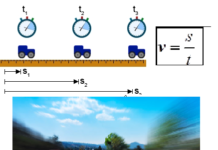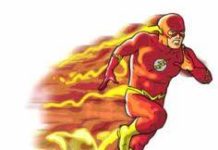What size do we measure when a body moves? How long have we been traveling? How much far we have traveled? How fast have we arrived? The following sizes we measure when moving:
Preceeded Way – The part of the path that a body crosses for a certain time is called a journey. The path is a series of consecutive ranges between the two positions measured on the path. The path is a scalar size.
Example: The boy crossed the two-meter road. The number is two
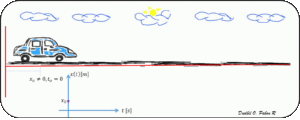
Path traveled – A part of the path that a body passesafter a certain period of time is called the traveled path. The path is a series of successive distances between two positions measured on the path. The path is a scalar dimension.
Example: The boy traveled a two-meter road. The number two is marked.
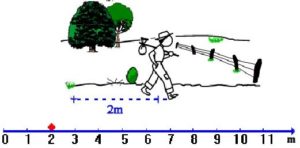
 Displacement – represents the shortest possible distance between the initial and final position of a body at a certain time interval. We need to be moving in order to go from home to school. A displacement would be a straight line distance between these two places. However, the distance traveled depends on the streets that each of us chooses to reach a certain place. A shift is a vector that connects the start point and the end of the path (Figure 1) which body crosses for a certain time. The path is measured along the path by which the body moves. Thus, the shift is the vector quantity. The shift has the same numerical value as the path only when the body moves in straight line in the same direction and does not change the direction of movement.
Displacement – represents the shortest possible distance between the initial and final position of a body at a certain time interval. We need to be moving in order to go from home to school. A displacement would be a straight line distance between these two places. However, the distance traveled depends on the streets that each of us chooses to reach a certain place. A shift is a vector that connects the start point and the end of the path (Figure 1) which body crosses for a certain time. The path is measured along the path by which the body moves. Thus, the shift is the vector quantity. The shift has the same numerical value as the path only when the body moves in straight line in the same direction and does not change the direction of movement.

 Example: The point A is the house, and the point B is the school, and the blue arrows represents the paith. Pink arrow shows the displacement or the shortest distance from home to school. The image below shows the path of a man in red, and the shift in blue.
Example: The point A is the house, and the point B is the school, and the blue arrows represents the paith. Pink arrow shows the displacement or the shortest distance from home to school. The image below shows the path of a man in red, and the shift in blue.
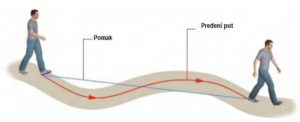
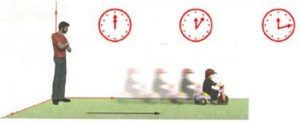 Time (t) Each movement starts at a specific time t1, and ends at a time t2. This movement occurs at a certain time interval Δt = t2 – t1 Let the car move at the straight line in the same direction. If x1 is the starting position vector, and with x2 the boy’s destination vector. The shift of the car in the time interval Δt = t2 – t1 is Δx = x2 – x1.
Time (t) Each movement starts at a specific time t1, and ends at a time t2. This movement occurs at a certain time interval Δt = t2 – t1 Let the car move at the straight line in the same direction. If x1 is the starting position vector, and with x2 the boy’s destination vector. The shift of the car in the time interval Δt = t2 – t1 is Δx = x2 – x1.


Speed – represents the velocity of movement, which is denoted by v. The unit for speed is meter per second (m / s). We have three speeds:
– average speed,
– average velocity,
– finaly speed.
The average speed is obtained by dividing the path Δs at a specified time interval (Δt) with that time interval.
![]()
The average velocity is obtained if we divide the shift with a time interval.

 Example 1: The car moves from the point from point A to point B. From point B, it returns to the point in point C. AC is the shift Δx.
Example 1: The car moves from the point from point A to point B. From point B, it returns to the point in point C. AC is the shift Δx.
 The finaly speed is the speed that the body has at a certain time, i.e. when Δt is very small. According to the speed of movement of the body, the movement can be staright and changeable. Straight movement is the movement in which the intensity of the speed over time does not change. With variable movement over time, the speed changes. The simplest example of the straight movement is the straight line movement, where the direction of movement does not change. In such motion, the velocity vector does not change during movement.
The finaly speed is the speed that the body has at a certain time, i.e. when Δt is very small. According to the speed of movement of the body, the movement can be staright and changeable. Straight movement is the movement in which the intensity of the speed over time does not change. With variable movement over time, the speed changes. The simplest example of the straight movement is the straight line movement, where the direction of movement does not change. In such motion, the velocity vector does not change during movement.

(v = const)
In this case, the average speed, the average velocity, and the finaly speed are the same size, and then we are talking only about one speed of even straight line motion.





